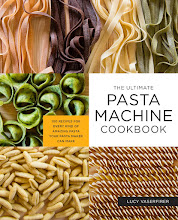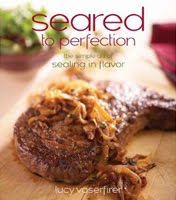
Springtime at the farmers market means greens. Lush, vibrant greens. Crisp greens, tender greens. Greens of every shade and hue that make you want to get into the kitchen and cook something nourishing and delicious.

Look what one bunch of kale can inspire.

Before I get to the recipe, a newsflash about my forthcoming cookbook Seared to Perfection: The Simple Art of Sealing in Flavor: Amazon is now showing the image of the cover! Doesn’t that juicy steak just make your mouth water?
White Bean & Roasted Garlic Soup with Tuscan Kale & Italian Sausage
Printable Recipe
2 heads garlic
¼ cup extra virgin olive oil
Kosher salt
¾ pound bulk Italian sausage, crumbled
¼ cup white wine
1 quart chicken broth
2 19-ounce cans cannellini beans, rinsed and drained
1 12-ounce bunch Tuscan kale, stemmed and cut into 1-inch strips
Freshly ground black pepper
Preheat the oven to 350˚F. Cut the stem ends off the heads of garlic to expose the cloves within. Place the garlic in the center of a piece of aluminum foil, drizzle with 2 tablespoons of the oil, sprinkle with kosher salt, and seal the foil tightly. Roast for 40 to 45 minutes, or until meltingly tender and golden brown. Let cool to room temperature and peel.
Heat a large, heavy pot over medium-high heat until very hot but not smoking. Add the remaining 2 tablespoons of oil and swirl to coat the bottom of the pot. Add the sausage and cook for 5 to 6 minutes, tossing about 3 times, until crusty and brown in spots.* Using a slotted spoon, remove the sausage to a plate. Add the wine to the pot and simmer for 2 to 3 minutes, scraping up the brown bits from the bottom of the pan with a heat-proof spatula. Add the broth, beans, and roasted garlic along with its oil, remove from the heat, and puree with an immersion blender until smooth. Return to the heat and bring to a boil. Return the sausage to the pot, add the kale, and simmer, stirring occasionally, for 10 to 12 minutes, or until the kale is tender. Season to taste with salt and pepper. Ladle into bowls and serve immediately.
Serves 4 as a main course. Using canned instead of dried beans makes this recipe quick and easy enough for a weeknight. If you have the choice between hot and sweet Italian sausage, go for hot. Tuscan kale is also known as Italian kale, cavolo nero, lacinato kale, black kale, and dinosaur kale. If you don’t have an immersion blender, you can use a regular blender. For a hearty and satisfying dinner, serve this Italian-inspired soup with plenty of crusty bread.
*Searing the sausage in this manner adds tons of flavor to the finished dish. For everything you ever wanted to know about searing, plus dozens of fabulous searing recipes, look for my book Seared to Perfection in stores in October.


















